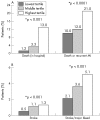Intervention in acute coronary syndromes: do patients undergo intervention on the basis of their risk characteristics? The Global Registry of Acute Coronary Events (GRACE)
- PMID: 16757543
- PMCID: PMC1861403
- DOI: 10.1136/hrt.2005.084830
Intervention in acute coronary syndromes: do patients undergo intervention on the basis of their risk characteristics? The Global Registry of Acute Coronary Events (GRACE)
Abstract
Objective: To determine whether revascularisation is more likely to be performed in higher-risk patients and whether the findings are influenced by hospitals adopting more or less aggressive revascularisation strategies.
Methods: GRACE (Global Registry of Acute Coronary Events) is a multinational, observational cohort study. This study involved 24,189 patients enrolled at 73 hospitals with on-site angiographic facilities.
Results: Overall, 32.5% of patients with a non-ST elevation acute coronary syndrome (ACS) underwent percutaneous coronary intervention (PCI; 53.7% in ST segment elevation myocardial infarction (STEMI)) and 7.2% underwent coronary artery bypass grafting (CABG; 4.0% in STEMI). The cumulative rate of in-hospital death rose correspondingly with the GRACE risk score (variables: age, Killip class, systolic blood pressure, ST segment deviation, cardiac arrest at admission, serum creatinine, raised cardiac markers, heart rate), from 1.2% in low-risk to 3.3% in medium-risk and 13.0% in high-risk patients (c statistic = 0.83). PCI procedures were more likely to be performed in low- (40% non-STEMI, 60% STEMI) than medium- (35%, 54%) or high-risk patients (25%, 41%). No such gradient was apparent for patients undergoing CABG. These findings were seen in STEMI and non-ST elevation ACS, in all geographical regions and irrespective of whether hospitals adopted low (4.2-33.7%, n = 7210 observations), medium (35.7-51.4%, n = 7913 observations) or high rates (52.6-77.0%, n = 8942 observations) of intervention.
Conclusions: A risk-averse strategy to angiography appears to be widely adopted. Proceeding to PCI relates to referral practice and angiographic findings rather than the patient's risk status. Systematic and accurate risk stratification may allow higher-risk patients to be selected for revascularisation procedures, in contrast to current international practice.
Conflict of interest statement
Competing interests: KAAF: British Heart Foundation, Medical Research Council, Wellcome Trust, sanofi‐aventis; FAA: sanofi‐aventis; OHD: no conflicts to disclose; PGS: sanofi‐aventis; JL‐S: sanofi‐aventis, Pfizer, the TIMI group, BMS, Medtronic and Guidant; FV: Boehringer Ingelheim, sanofi‐aventis, Proctor and Gamble, Servier, Novartis, MSD and Schering Plough; A Budaj: sanofi‐aventis; EPG: sanofi‐aventis, Lilly and Astra Zeneca; SGG: sanofi‐aventis, AstraZeneca, Boehringer Ingelheim, Bristol‐Myers Squibb, Glaxo Smith Kline, Hoffmann‐LaRoche Pharmaceuticals, Merck & Co, Inc, Novartis, Pfizer Inc, Sanofi‐Synthelabo, Schering Corporation, Millennium Pharmaceuticals, Inc and The Medicines Company; DB: sanofi‐aventis.
Comment in
-
Underuse of revascularisation in acute coronary syndromes.Heart. 2007 Feb;93(2):147-8. doi: 10.1136/hrt.2006.092643. Heart. 2007. PMID: 17228067 Free PMC article.
References
-
- Keeley E C, Boura J A, Grines C L. Primary angioplasty versus intravenous thrombolytic therapy for acute myocardial infarction: a quantitative review of 23 randomised trials. Lancet 200336113–20. - PubMed
-
- FRISC II Investigators Invasive compared with non‐invasive treatment in unstable coronary‐artery disease: FRISC II prospective randomised multicentre study. Lancet 1999354708–715. - PubMed
-
- Fox K A, Poole‐Wilson P A, Henderson R A.et al Interventional versus conservative treatment for patients with unstable angina or non‐ST‐elevation myocardial infarction: the British Heart Foundation RITA 3 randomised trial. Randomized Intervention Trial of unstable Angina. Lancet 2002360743–751. - PubMed
Publication types
MeSH terms
LinkOut - more resources
Full Text Sources
Medical
Miscellaneous



